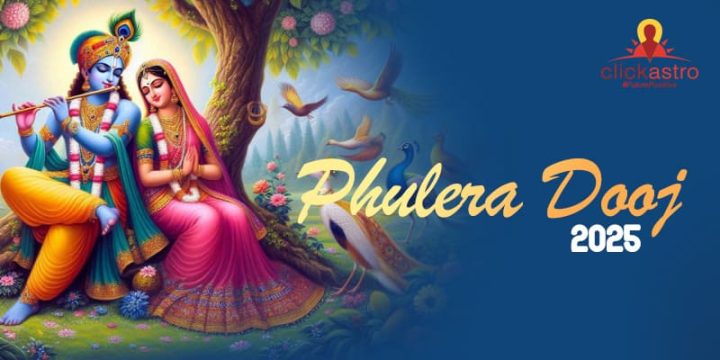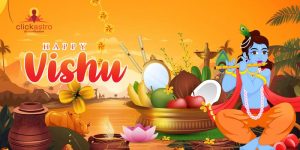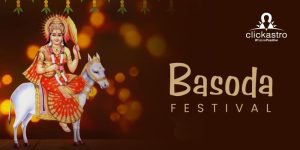Contents[hide]
What is Phulera Dooj?
One of the most iconic and beautiful festivals celebrated in India, Phulera Dooj is a festival honouring the deity Lord Krishna. In keeping with his childlike and enthusiastic nature, the worshippers of Lord Krishna celebrate this festival with great enthusiasm and fervour. The festival is mostly celebrated in the northern states of India, as Lord Krishna belongs to the Uttar Pradesh region. The festival is observed on the ‘Dwitiya’ or second day of the Shukla Paksha, during the Hindu month of Phalgun. According to the Gregorian calendar, the date falls during February and March. From the name itself, we can understand that the festival is celebrated with phul or flowers and, on Phulera Dooj, devotees honour Lord Krishna by playing with flowers. It is similar to Holi, where people play with colours. Both festivals are celebrated with the hope of adding colour and vibrancy to life.What is the Auspicious Date and Time of Phulera Dooj?
In 2025, the auspicious festival of Phulera Dooj falls on March 01, Saturday. It is placed between the festivals of Vasant Panchami and Holi and, since Phulera Dooj is considered a harbinger of Holi, most of the rituals followed on this day, and the sentiment behind the celebration, are linked with Holi. During Phulera Dooj, devotees await a glance of the special ‘darshan’ and it is believed that this is the time when Lord Krishna is getting ready to enjoy the festival of Holi, slated just a few days after Phulera Dooj. Since the festival is mostly celebrated in northern India, you can catch a glimpse of the celebrations across temples in Mathura and Vrindavan. Temples here organise Special rituals on Phulera Dooj and smear the idols of Lord Krishna with a few colours, heralding the beginning of the Holi celebrations.This year, the festival will be commemorated on the Dwitiya tithi in the bright phase or Sukla Paksha, with the celebration beginning on March 1, at 3:16 AM, and culminating at 12:09 AM on March 2, 2025.
What is the history of Phulera Dooj?
Phulera Dooj is the festival celebrating the strong love and affection between Lord Krishna and Radha. Mythology states that Radha was once extremely upset with Krishna because he was not meeting her. He was immersed in work in Vrindavan and had ended up making her unhappy. Due to Radha’s unhappiness, nature began to suffer, with flowers, and cattle dying in the region. When Lord Krishna heard this, he immediately rushed to Mathura and reached Radha on the second day of Phalgun month. Phulera Dooj is celebrated as the day Lord Krishna reached Radha and played Holi with flowers to make her happy. Further, Phulera Dooj is also known as Abuja Muhurta, a day when people can begin all auspicious work without consulting the Panchang. Devotees of Radha-Krishna also get special blessings on this day, making it an occasion celebrating love and passion.How is Phulera Dooj celebrated?
This festival is celebrated in North India and devotees believe that worshipping Lord Krishna with full devotion will help them live a life of prosperity and happiness. People celebrate this auspicious day by decorating their homes and idols of Lord Krishna with beautiful and colourful flowers. It is almost as if people are playing Holi with flowers, instead of colours. Beautiful rangolis are also drawn on the verandas and outside houses. Devotees also prepare delicacies for Lord Krishna and offer these to the idols at home or in Krishna temples. Most devotees prepare poha as it is considered as Prasad or holy offering. Since the ethereal couple of Radha-Krishna are supposed to fulfil all desires of devotees, on Phulera Dooj, people in Northern India usually shower flowers on each other, and on idols, to express the love and bond between Radha and Krishna. Lord Krishna spent most of his life in the Braj region of Uttar Pradesh, so temples in this area, and its neighbouring regions, celebrate Phulera Dooj by organising special events and beautifully decorating the temples. Devotees from far and wide come to Braj, Mathura and Vrindavan to honour Lord Krishna and seek his blessings while partaking in this beautiful and auspicious festival. During the festival, Lord Krishna’s idol is adorned with a white dress and he is seated under a colourful and florally decorated mandap. To further intimate the coming of Holi, a piece of cloth with a gulal on it is tied to Lord Krishna’s waist. This indicates that he is preparing to celebrate Holi. This colour and gulal are removed after the ‘Shayan Bhog’, at night, as the deity prepares for rest. There is an ambience of joy and celebration across the region and devotees prepare a special ‘Bhog’ or offering on this day. While poha is a speciality, other recipes are also made as Prasad and, after offering this to Lord Krishna, the devotees offer the remaining Prasad to other worshippers. The day is also marked by ‘Sandhya Aarti’ and ‘Samaj mein rasiya’, which are considered the main rituals of Phulera Dooj. Strong participation is witnessed from the devotees, who spend the day in temples singing ‘bhajans’ or devotional songs praising Lord Krishna. After applying some colours to the idol of Lord Krishna, the priests or pundits sprinkle colour or gulal on all the devotees. All these rituals are followed and practised in the region of Mathura, Braj and Vrindavan and it is a sight to behold. Read about Akshaya TritityaWhat is the significance of Phulera Dooj
Phulera Dooj is very important in the Hindu mythology. According to astronomical calculations, the occasion of Phulera Dooj is considered very auspicious. This is because astronomy states that every moment of Phulera Dooj is free from all ‘Dosha’ or defects. This is why this day is also known as ‘Abuja muhurat’. Given the blessed and auspicious nature of this day, many North Indians celebrate marriage ceremonies on this special day. Also, it is believed that there is no better day to begin a business venture.Download Your Free Horoscope Compatibility Report







